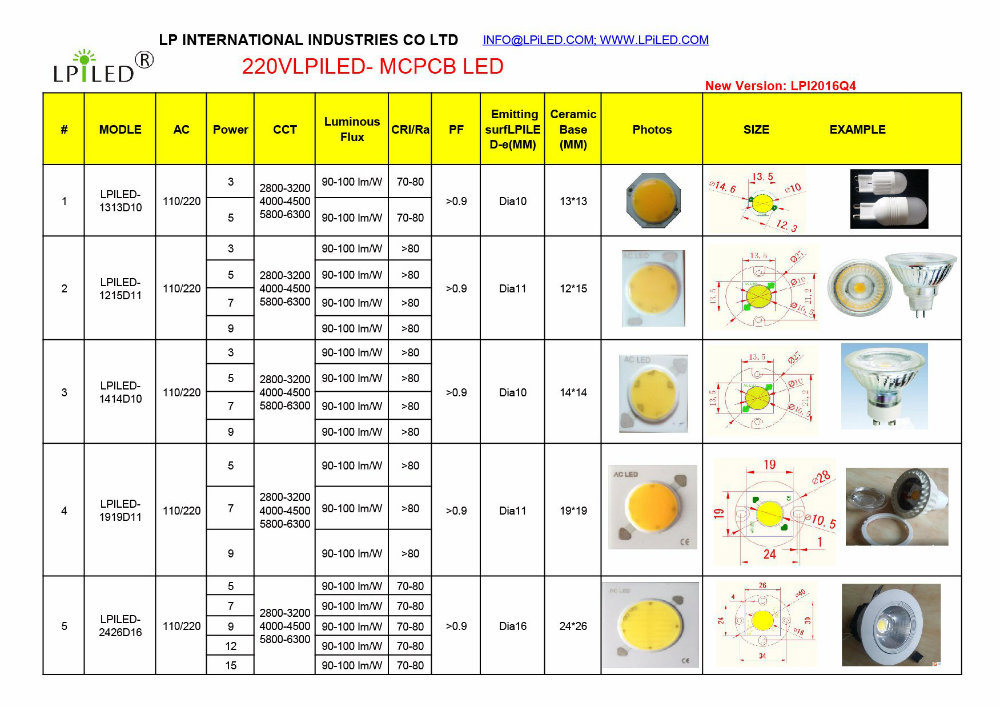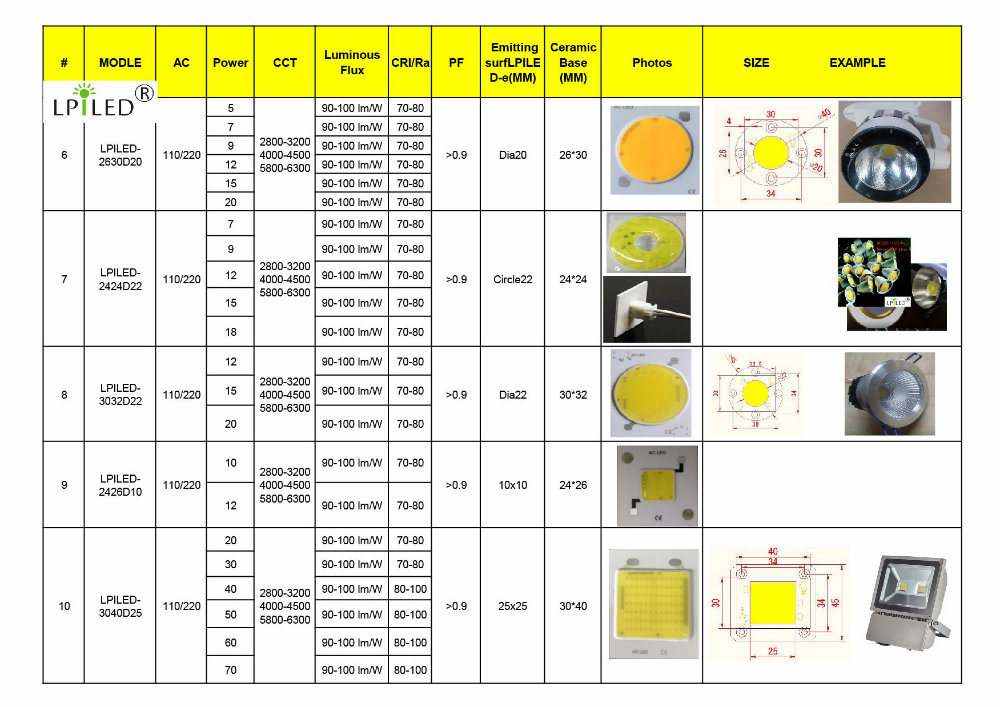Model NO.: LPILED-AC50
LED Packaging Type: Circle
Base Material: Ceramic
Life: 80000h
Certification: IMQ, KEMA, LVD, EMC, GOST, PSE, NOM, C-tick, SAA, FCC, Energy Star, CSA, GS, CCC, UL, RoHS
Trademark: LPILED, LPINTE
Transport Package: Bulk
Origin: China
Model NO.: LPILED-AC50
LED Packaging Type: Circle
Base Material: Ceramic
Life: 80000h
Certification: IMQ, KEMA, LVD, EMC, GOST, PSE, NOM, C-tick, SAA, FCC, Energy Star, CSA, GS, CCC, UL, RoHS
Trademark: LPILED, LPINTE
Transport Package: Bulk
Origin: China
AC COB LED with cable wire110V/220V COB LED
No need led driver or ballast
LPILED-ACLED-D28
Voltage: Â 110V/220V AC
Ceramic Base, Size: 30X40mm
Light Area: 28mm
With Socket at the bottom, easy assembly with cable wire
Socket Cable Hole Diameter: 10mmÂ
CCT: 2700-3000K; 4000-4500K; 5500-6000K; Mass order customzied
CRI normal Ra80, Customized 90,95 avaialble
Luminous flux: 90~110lm/W
Power available: 20w,30w,40w,50w
Apply for: led bulb, led spotlight, led down light......
Install: use silicone paste K-5204K




LPILED,A light-emitting diode (LED) is a two-lead semiconductor light source. It is a p-n junction diode, which emits light when activated. When a suitable voltage is applied to the leads, electrons are able to recombine with electron holes within the device, releasing energy in the form of photons. This effect is called electroluminescence, and the color of the light (corresponding to the energy of the photon) is determined by the energy band gap of the semiconductor.
Â
An LED is often small in area (less than 1 mm2) and integrated optical components may be used to shape its radiation pattern.
Appearing as practical electronic components in 1962, the earliest LEDs emitted low-intensity infrared light. Infrared LEDs are still frequently used as transmitting elements in remote-control circuits, such as those in remote controls for a wide variety of consumer electronics. The first visible-light LEDs were also of low intensity, and limited to red. Modern LEDs are available across the visible, ultraviolet, and infrared wavelengths, with very high brightness.
Â
Early LEDs were often used as indicator lamps for electronic devices, replacing small incandescent bulbs. They were soon packaged into numeric readouts in the form of seven-segment displays, and were commonly seen in digital clocks. LPILED
Â
Recent developments in LEDs permit them to be used in environmental and task lighting. LEDs have many advantages over incandescent light sources including lower energy consumption, longer lifetime, improved physical robustness, smaller size, and faster switching. Light-emitting diodes are now used in applications as diverse as aviation lighting, automotive headlamps, advertising, general lighting, traffic signals, camera flashes and lighted wallpaper. As of 2015, LEDs powerful enough for room lighting remain somewhat more expensive, and require more precise current and heat management, than compact fluorescent lamp sources of comparable output.
Â
LEDs have allowed new text, video displays, and sensors to be developed, while their high switching rates are also used in advanced communications technology.
Â
Â
Â
"SMD LED" is an abbreviation for Surface-Mounted-Device Light-Emitting Diode. An SMD LED Module is a type of LED module that uses Surface-mount technology (SMT) to mount LED chips on printed circuit boards (PCB). It is a self-contained Surface-Mount LED device designed either to function on its own or to plug into a compatible unit.
Â
The types of SMD LED Modules are distinguished by the dimensions of the LED package. Common types are 5050 SMD LED Module, 3528 SMD LED Module, 3020 SMD LED Module, 5630 SMD LED Module.[2] The brightness may vary depending on the input voltage inversely affecting the device's lifespan.
Â
Application
SMD LED modules are widely used, in LED lamps, for backlighting, home illumination, shop-windows, advertising, automobile interior lighting, Christmas lights, and numerous lighting applications.
Â
AC COB LED with cable wire110V/220V COB LED
No need led driver or ballast
LPILED-ACLED-D28
Voltage: Â 110V/220V AC
Ceramic Base, Size: 30X40mm
Light Area: 28mm
With Socket at the bottom, easy assembly with cable wire
Socket Cable Hole Diameter: 10mmÂ
CCT: 2700-3000K; 4000-4500K; 5500-6000K; Mass order customzied
CRI normal Ra80, Customized 90,95 avaialble
Luminous flux: 90~110lm/W
Power available: 20w,30w,40w,50w
Apply for: led bulb, led spotlight, led down light......
Install: use silicone paste K-5204K




LPILED,A light-emitting diode (LED) is a two-lead semiconductor light source. It is a p-n junction diode, which emits light when activated. When a suitable voltage is applied to the leads, electrons are able to recombine with electron holes within the device, releasing energy in the form of photons. This effect is called electroluminescence, and the color of the light (corresponding to the energy of the photon) is determined by the energy band gap of the semiconductor.
Â
An LED is often small in area (less than 1 mm2) and integrated optical components may be used to shape its radiation pattern.
Appearing as practical electronic components in 1962, the earliest LEDs emitted low-intensity infrared light. Infrared LEDs are still frequently used as transmitting elements in remote-control circuits, such as those in remote controls for a wide variety of consumer electronics. The first visible-light LEDs were also of low intensity, and limited to red. Modern LEDs are available across the visible, ultraviolet, and infrared wavelengths, with very high brightness.
Â
Early LEDs were often used as indicator lamps for electronic devices, replacing small incandescent bulbs. They were soon packaged into numeric readouts in the form of seven-segment displays, and were commonly seen in digital clocks. LPILED
Â
Recent developments in LEDs permit them to be used in environmental and task lighting. LEDs have many advantages over incandescent light sources including lower energy consumption, longer lifetime, improved physical robustness, smaller size, and faster switching. Light-emitting diodes are now used in applications as diverse as aviation lighting, automotive headlamps, advertising, general lighting, traffic signals, camera flashes and lighted wallpaper. As of 2015, LEDs powerful enough for room lighting remain somewhat more expensive, and require more precise current and heat management, than compact fluorescent lamp sources of comparable output.
Â
LEDs have allowed new text, video displays, and sensors to be developed, while their high switching rates are also used in advanced communications technology.
Â
Â
Â
"SMD LED" is an abbreviation for Surface-Mounted-Device Light-Emitting Diode. An SMD LED Module is a type of LED module that uses Surface-mount technology (SMT) to mount LED chips on printed circuit boards (PCB). It is a self-contained Surface-Mount LED device designed either to function on its own or to plug into a compatible unit.
Â
The types of SMD LED Modules are distinguished by the dimensions of the LED package. Common types are 5050 SMD LED Module, 3528 SMD LED Module, 3020 SMD LED Module, 5630 SMD LED Module.[2] The brightness may vary depending on the input voltage inversely affecting the device's lifespan.
Â
Application
SMD LED modules are widely used, in LED lamps, for backlighting, home illumination, shop-windows, advertising, automobile interior lighting, Christmas lights, and numerous lighting applications.
Â
KVM Switcher,VGA USB KVM Extender,4 Port KVM Switcher
HDMI Extender HDMI Splitter CO.,LTD , http://www.nsconverter.com